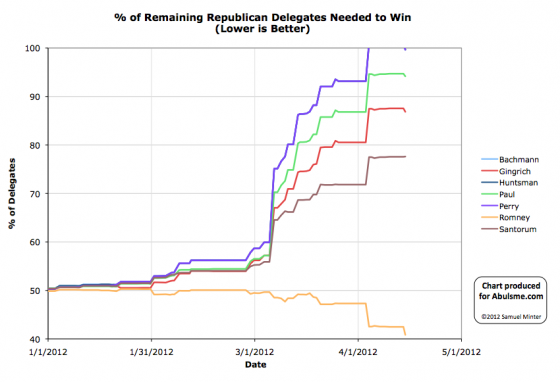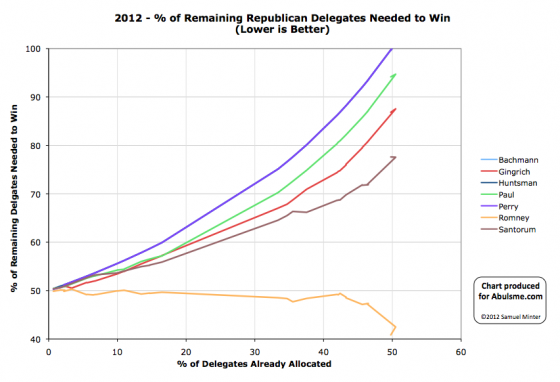Charts from the Abulsme.com 2012 Republican Delegate Count Graphs page. When a candidate gets down to 0%, they have clinched the nomination. If they get above 100%, they have been mathematically eliminated. The first chart is by date, the second is by “% of Delegates Already Allocated”. These numbers include estimates of the eventual results of multi-stage caucus processes which will be refined as the later stages occur.
Wyoming and Colorado both have caucus type delegate allocation systems, where local caucuses earlier in the year are actually just the start of multi-month multi-stage processes. Both Colorado and Wyoming had their state conventions this weekend finishing off the delegate selection in those states.
Compared to the earlier estimates based on caucus results, the non-Romneys got crushed. Romney gained delegates. Everybody else lost delegates.
This is not surprising. It is common for the “clear winner” to end up taking far more delegates in the end than it looked like they would given the “straw poll” results at the first stage.
Looking more specifically…
- Colorado: The estimates after the caucuses were Santorum 13, Romney 12, Gingrich 4, Paul 4, and 3 uncommitted. This now becomes Romney 13, Santorum 6, and 17 uncommitted. All 36 delegates from Colorado are officially uncommitted, but using the current stated preferences of the delegates we have a net today from Colorado of Romney +1, Gingrich -4, Paul -4, Santorum -7.
- Wyoming: The estimates after the caucuses were Romney 11, Santorum 8, Paul 6, Gingrich 2, and 2 uncommitted. This now becomes Romney 22, Santorum 2, Paul 1, and 4 uncommitted. In Wyoming the delegates are bound. The net for the day in Wyoming is Romney +11, Gingrich -2, Paul -5, Santorum -6
Totaling the day we have Romney +12, Gingrich -6, Paul -9, Santorum -13. This does not look like a good day for the non-Romneys. Especially for Santorum. I guess dropping out of the race doesn’t help one’s ability to compete for delegates.
Notice though that we actually lost 16 delegates from the totals as some delegates that were predicted to go for specific candidates ended up uncommitted to any candidate. This actually increases the pool of potentially available delegates. In theory this improves the situation slightly for Gingrich and Paul, because, hey, they might still convince those uncommitted delegates to vote for them. (And indeed, some reports say many of those uncommitted delegates aren’t ready to support anybody else yet, but are not for Romney at this point either.) Santorum lost enough delegates that his situation actually gets worse anyway.
In terms of “% of remaining delegates needed to win”:
- Romney: 42.49% -> 40.85%
- Santorum: 77.56% -> 77.61%
- Gingrich: 87.54% -> 86.85%
- Paul: 94.70% -> 94.16%
I should also mention, that having these additional 16 delegates not committed brings the total number of delegates allocated by the estimates we use (the Green Papers soft count) back under 50% of the total number of delegates. Which actually means that the candidates with no delegates right now (Bachman, Huntsman, Perry, random others) are now no longer mathematically eliminated, and could catch up and win by capturing 99.65% of the remaining delegates. If they were actually on the ballot on all of the remaining states. Which they are not. :-)
So, uh, anyway… Romney still wins.


This is crap! I think you will be surprised at the convention when a lot of these delegates that you claim are Romneys vote for Ron Paul.
The source I use for the delegate counts (Green Papers) is generally very well sourced. Those listed as Romney delegates in their soft count are generally either actually bound by primary results, have specifically endorsed Romney publicly (although unbound delegates can always change their minds), or are estimates based on preliminary caucus results. In the latter case, those estimates can and will change as the caucus process proceeds.
In the case of Colorado and Wyoming, the actual number of Romney delegates coming out of the process was actually GREATER than had been estimated based on the original caucus results. As I mentioned in the post above, this is actually normal in states that have multi-stage caucus processes. Whoever is ahead in the overall total tends to over perform in the later caucus stages than would have been expected given the initial results.
So we have three potential ways that Romney’s total actually includes people who end up voting for Paul.
#1) Delegates elected under a false flag, claiming to support Romney in order to get elected as a delegate with a plan to only reveal their true preference at the convention. This kind of thing is very easy in the early stage of caucus processes, but as the processes move forward, you get more and more of the die-hard people associated with campaigns and local party organizations elected to the next level and this is much harder to sustain. And of course in primary states this is essentially impossible. If this happens at all, the numbers will be very small.
#2) Delegates who change their mind after being elected. Most delegates to the national convention are “bound” and required to vote for the candidate they were selected for at least for the first ballot. But many are not. (If the candidates who drop out “release” their delegates, there will be more, but that hasn’t happened yet.) If you look at the Green Papers Hard Count instead of their Soft Count, you see that at this point there are actually 280 delegates who are officially uncommitted, meaning that they are not bound in any way at the convention and can vote for whoever they want. The soft count divides most of these delegates up to the various candidates though, based on the stated preferences of these delegates, or the candidate they were elected “for”. These delegates can change their minds, but in most cases they were selected specifically because they were strong supporters of their candidates, so the chances of them changing their minds is low.
#3) Estimates for caucus process states overestimating Romneys support. This is very possible. Paul’s strategy in general counted on being well organized in caucuses so as to take more delegates than his initial straw poll results would indicate. This may yet still happen in some states. But so far, in states that have completed their processes, Romney has actually gotten more delegates than initially expected, not less.
Now, it is quite possible that some of the delegates listed as uncommitted even in the Green Papers soft count may be Paul delegates in the end. But there are only 28 of those at the moment.
Also of course, defections may happen in the other direction. In 2008 the “final” delegate count at the end of the primary season was McCain 1575, Huckabee 278, Romney 271, Paul 35… with 221 undetermined. But the actual roll call vote at the convention was McCain 2343, Paul 15, Romney 2, and 20 not voting. Delegates tend to end up supporting the “winner” in the end, regardless of who they originally supported. If there was no clear winner by the convention this would of course be different. That does not appear to be the case this time though.